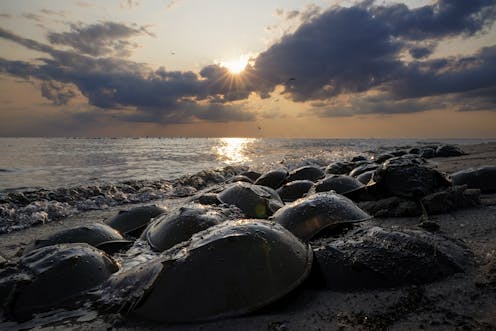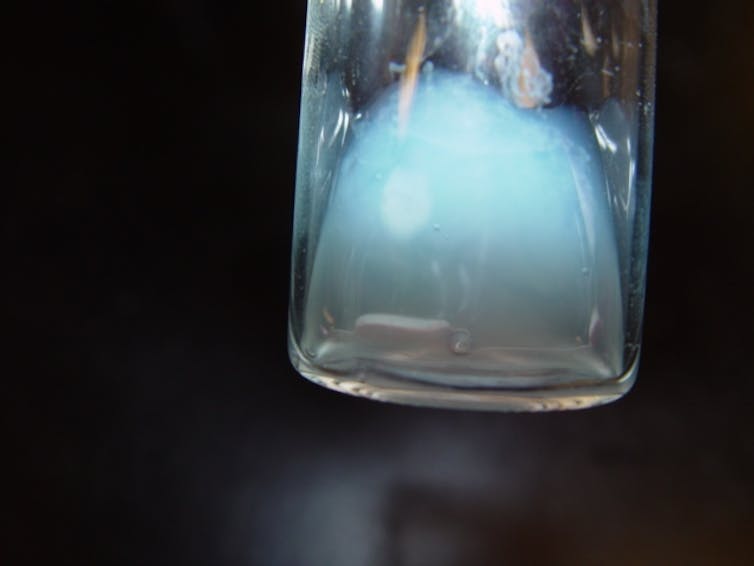Horseshoe crab blood is vital for testing intravenous drugs, but new synthetic alternatives could mean pharma won't bleed this unique species dry
- Written by Kristoffer Whitney, Associate Professor of Science, Technology and Society, Rochester Institute of Technology
 Horseshoe crabs in spawning season at Reeds Beach, N.J., on June 13, 2023.AP Photo/Matt Rourke
Horseshoe crabs in spawning season at Reeds Beach, N.J., on June 13, 2023.AP Photo/Matt RourkeIf you have ever gotten a vaccine or received an intravenous drug and did not come down with a potentially life-threatening fever, you can thank a horseshoe crab (Limulus polyphemus).
How can animals that are often called living fossils, because they have barely changed over millions of years, be so important in modern medicine? Horseshoe crab blood is used to produce a substance called limulus amebocyte lysate, or LAL, which scientists use to test for toxic substances called endotoxins in intravenous drugs.
These toxins, produced by bacteria, are ubiquitous in the environment and can’t be removed simply through sterilization. They can cause a reaction historically referred to as “injection fever.” A strong concentration can lead to shock and even death.
Identifying LAL as a highly sensitive detector of endotoxins was a 20th-century medical safety breakthrough. Now, however, critics are raising questions about environmental impacts and the process for reviewing and approving synthetic alternatives to horseshoe crab blood.
We study science, technology and public policy, and recently published a white paper examining social, political and economic issues associated with using horseshoe crabs to produce LAL. We see this issue as a test case for complicated problems that cut across multiple agencies and require attention to both nature and human health.
Protecting horseshoe crabs will require persuading the heavily regulated pharmaceutical industry to embrace change.An ocean solution
Doctors began injecting patients with various solutions in the mid-1800s, but it was not until the 1920s that biochemist Florence Seibert discovered that febrile reactions were due to contaminated water in these solutions. She created a method for detecting and removing the substances that caused this reaction, and it became the medical standard in the 1940s.
Known as the rabbit pyrogen test, it required scientists to inject intravenous drugs into rabbits, then monitor the animals. A feverish rabbit meant that a batch of drugs was contaminated.
The LAL method was discovered by accident. Working with horseshoe crabs at the Marine Biological Laboratory at Woods Hole, Massachusetts, in the 1950s and ’60s, pathobiologist Frederik Bang and medical researcher Jack Levin noticed that the animals’ blue blood coagulated in a curious manner. Through a series of experiments, they isolated endotoxin as the coagulant and devised a method for extracting LAL from the blood. This compound would gel or clot nearly instantaneously in the presence of fever-inducing toxins.
Academic researchers, biomedical companies and the U.S. Food and Drug Administration refined LAL production and measured it against the rabbit test. By the 1990s, LAL was the FDA-approved method for testing medicines for endotoxin, largely replacing rabbits.
Producing LAL requires harvesting horseshoe crabs from oceans and beaches, draining up to 30% of their blood in a laboratory and returning the live crabs to the ocean. There’s dispute about how many crabs die in the process – estimates range from a few percent to 30% or more – and about possible harmful effects on survivors.
Today there are five FDA-licensed LAL producers along the U.S. East Coast. The amount of LAL they produce, and its sales value, are proprietary.
Bait versus biotech
As biomedical LAL production ramped up in the 1990s, so did harvesting horseshoe crabs to use as bait for other species, particularly eel and whelk for foreign seafood markets. Over the past 25 years, hundreds of thousands – and in the early years, millions – of horseshoe crabs have been harvested each year for these purposes. Combined, the two fisheries kill over half a million horseshoe crabs every year.
There’s no agreed total population estimate for Limulus, but the most recent federal assessment of horseshoe crab fisheries found the population was neither strongly growing nor declining.
Conservationists are worried, and not just about the crabs. Millions of shorebirds migrate along the Atlantic coast, and many stop in spring, when horseshoe crabs spawn on mid-Atlantic beaches, to feed on the crabs’ eggs. Particularly for red knots – a species that can migrate up to 9,000 miles between the tip of South America and the Canadian Arctic – gorging on horseshoe crab eggs provides a critical energy-rich boost on their grueling journey.
Red knots were listed as threatened under the Endangered Species Act in 2015, largely because horseshoe crab fishing threatened this key food source. As biomedical crab harvests came to equal or surpass bait harvests, conservation groups began calling on the LAL industry to find new sources.
Biomedical alternatives
Many important medicines are derived from living organisms. Penicillin, the first important antibiotic, was originally produced from molds. Other medicines currently in use come from sources including cows, pigs, chickens and fish. The ocean is a promising source for such products.
When possible, synthesizing these substances in laboratories – especially widely used medications like insulin – offers many benefits. It’s typically cheaper and more efficient, and it avoids putting species at risk, as well as addressing concerns some patients have about using animal-derived medical products.
In the 1990s, researchers at the National University of Singapore invented and patented the first process for creating a synthetic, endotoxin-detecting compound using horseshoe crab DNA and recombinant DNA technology. The result, dubbed recombinant Factor C (rFC), mimicked the first step in the three-part cascade reaction that occurs when LAL is exposed to endotoxin.
Later, several biomedical firms produced their own versions of rFC and compounds called recombinant cascade reagents (rCRs), which reproduce the entire LAL reaction without using horseshoe crab blood. Yet, today, LAL remains the dominant technology for detecting endotoxins in medicine.
 A sample of horseshoe crab blood.Florida Fish and Wildlife Commission, CC BY-NC-ND
A sample of horseshoe crab blood.Florida Fish and Wildlife Commission, CC BY-NC-NDThe main reason is that the U.S. Pharmacopeia, a quasi-regulatory organization that sets safety standards for medical products, considers rFC and rCR as “alternative” methods for detecting endotoxins, so they require case-by-case validation for use – a potentially lengthy and expensive process. The FDA generally defers to the U.S. Pharmacopeia.
A few large pharmaceutical companies with deep pockets have committed to switching from LAL to rFC. But most drug producers are sticking with the tried-and-true method.
Conservation groups want the U.S. Pharmacopeia to fully certify rFC for use in industry with no extra testing or validation. In their view, LAL producers are stalling rFC and rCR approval to protect their market in endotoxin detection. The U.S. Pharmacopeia and LAL producers counter that they are doing due diligence to protect public health.
Change in the offing
Change may be coming. All major LAL producers now have their own recombinant products – a tacit acknowledgment that markets and regulations are moving toward Limulus-free ways to test for endotoxins.
Atlantic fisheries regulators are currently considering new harvest limits for horseshoe crabs, and the U.S. Pharmacopeia is weighing guidance on recombinant alternatives to LAL. Public comments will be solicited over the winter of 2024, followed by U.S. Pharmacopeia and FDA review.
Even if rFC and rCR don’t win immediate approval, we believe that collecting more complete data on horseshoe crab populations and requiring more transparency from the LAL industry on how it handles the crabs would represent progress. So would directing medical companies to use recombinant products for testing during the manufacturing process, while saving LAL solely for final product testing.
Making policy on complex scientific issues across diverse agencies is never easy. But in our view, incremental actions that protect both human health and the environment could be important steps forward.
This material is based upon work supported by the National Science Foundation under Award No. 2121146, as well as the Leverhulme Trust through a Leverhulme Trust Research Project Grant. Any opinions, findings, and conclusions or recommendations expressed in this material are those of the author(s) and do not necessarily reflect the views of the National Science Foundation or the Leverhulme Trust.
Jolie Crunelle receives funding from the Aberg Family Fellowship at Rochester Institute of Technology.
Authors: Kristoffer Whitney, Associate Professor of Science, Technology and Society, Rochester Institute of Technology

